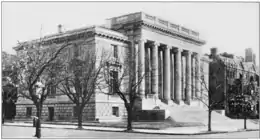Carnegie Institution
La Carnegie Institution de Washington est une fondation de recherche scientifique fondée en 1902 par Andrew Carnegie. Ses six axes de recherche sont : botanique, biologie du développement, écologie, géologie et planétologie, astronomie.
Carnegie Institution

| Fondation |
(Carnegie Institution of Washington) |
|---|---|
| Prédécesseur |
Carnegie Institution of Washington (d) |
| Type | |
|---|---|
| Forme juridique | |
| Siège | |
| Pays | |
| Coordonnées |
38° 54′ 34″ N, 77° 02′ 09″ O |
| Chiffre d'affaires |
72 946 617 dollars américains (), 90 205 505 dollars américains (), 137 841 470 dollars américains (), 73 959 417 dollars américains () |
|---|---|
| Site web |
(en) carnegiescience.edu |
| IRS |
|---|

L'institut a également soutenu des projets archéologiques au Mexique et en Amérique centrale (fouilles de Chichén Itzá, Copán, Uaxactùn, Kaminaljuyú) de 1913 à 1957[1] - [2] sous la direction notamment du mayaniste Sylvanus Morley.
Chercheurs renommés (ordre alphabétique)
Notes et références
- (en) The Carnegie Maya : the Carnegie Institution of Washington Maya research program, 1913-1957, , 803 p. (ISBN 978-0-87081-833-2).
- (en) « Carnegie Institution of Washington Photographs of Mayan Excavations (Peabody Museum of Archaeology and Ethnology, Harvard University) », sur artstor.org (consulté le ).
Voir aussi
Liens externes
- (en) Site officiel
- Ressources relatives à la recherche :
- Ressource relative aux beaux-arts :
Cet article est issu de wikipedia. Text licence: CC BY-SA 4.0, Des conditions supplémentaires peuvent s’appliquer aux fichiers multimédias.